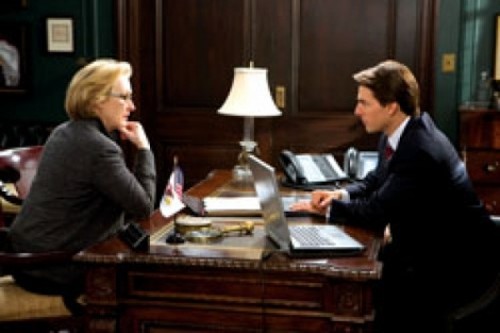Cinema | Figures of Speech: Lions for Lambs’ didacticism comes with surprising moral force.
By Scott Renshaw @scottrenshawIt’s hard to explain, then, why I found myself so unexpectedly moved by Lions for Lambs. This is the kind of movie I generally despise: A rhetorical exercise employing the mass medium of cinema while doing nothing particularly cinematic. But something here just clicked. The urge to analyze drained away as I found myself really thinking about what it had to say.
And there’s plenty of “saying” going on in two of its three primary subplots. In the first, journalist Janine Roth (Meryl Streep) spends an hour with Republican Sen. Jasper Irving (Tom Cruise) as he attempts to sell her an “exclusive” on a new strategy in the Afghanistan war. Meanwhile, in Afghanistan, Army Rangers Finch (Derek Luke) and Rodriguez (Michael Peña) get a taste of what that new strategy looks like in action. And at an unnamed “California university,” political-science professor Stephen Malley (Robert Redford) meets with talented but unmotivated student Todd (Andrew Garfield), and attempts to ignite his passion.
Redford (who also directed) and screenwriter Matthew Michael Carnahan (The Kingdom) flip back and forth between these three settings, eventually employing flashbacks that show Finch and Rodriguez when they, too, were students in Malley’s class. The Afghanistan sequences are the only ones that provide any physical action—the two soldiers find themselves stranded and injured in enemy territory after a mission goes awry—yet they’re actually the least intense moments in the film. While they’re undoubtedly meant to demonstrate the real-world consequences of the issues raised elsewhere in the film—and, at the same time, give the audiences a jolt between dialogue exchanges—the bullets firing back and forth ultimately prove less potent than the ideas firing back and forth.
Plenty of those ideas aren’t exactly new, and they’re not exactly nonpartisan. America’s Middle East “war on terrorism” campaigns were bungled, it says here; those who guide that foreign policy and shout about “supporting our troops” are really trying to support their sagging approval ratings. And yes, the “liberal media” screwed the pooch in pre-Iraq invasion 2003 by serving as a patriotic cheerleader rather than a skeptical inquirer. If this were all Lions for Lambs had to offer, you could stay at home and watch The Daily Show.
But even as the narrative revisits these familiar ideas, it explores something that should be just as obvious: A whole lot of Americans share culpability for this colossal screw-up. Lions for Lambs posits a national crisis resulting from a perfect storm of corrupted ideals—not just ideologue politicians and a timid, profit-driven journalistic establishment, but American citizens who have abandoned their own civic responsibilities out of ignorance, apathy or cynicism. Few choose to serve except as a last resort. And when some do choose to serve, the rest of us allow them to be chewed up and spit out, because we can’t be distracted—from our 24-hour Britney watch or our own smug superiority—to demand better. Like Pogo’s Walt Kelly, Carnahan and Redford have met the enemy, and they is us.
Maybe even this doesn’t seem like breaking news. The film certainly doesn’t dress up its theses in visual flourishes, favoring a style that just as easily could have worked on a theater stage. Streep and Cruise both shine during their left-vs.-right battle of wits—Cruise is never better than when he combines that megawatt smile with a dash of self-loathing—but otherwise it’s easy to imagine the story having roughly the same impact if you were reading the script. Plenty of people will be plenty put off by Lions for Lambs—by its Blue State sensibility or by its nakedly emotional call to action. And I can nod in agreement, even as I find it impossible to deny that this earnest, awkward little movie did something special: It made me want to be a better American.
LIONS FOR LAMBS
Tom Cruise
Meryl Streep
Robert Redford
Rated R
More by Scott Renshaw
-
Film Reviews: New Releases for April 19
The Ministry of Ungentlemanly Warfare, Abigail, The Beast, Hard Miles, Sasquatch Sunset and more
- Apr 19, 2024
-
Faces of Salt Lake County book and portrait reception
Images and personal stories in a new book reveal local demographic diversity
- Apr 17, 2024
-
Feature film review: THE BEAST
A filmmaker's compelling ideas get a bit tangled in references to his creative influences.
- Apr 17, 2024
- More »






